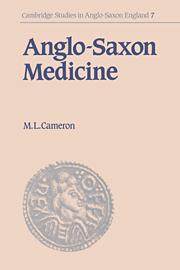Book contents
- Frontmatter
- Contents
- Preface
- Acknowledgements
- List of abbreviations
- 1 Introduction
- 2 Conditions for health and disease
- 3 Physician and patient
- 4 The earliest notices of Anglo-Saxon medical practice
- 5 Medical texts of the Anglo-Saxons
- 6 Compilations in Old English
- 7 Compilations in Latin
- 8 Latin works translated into Old English: Herbarium and Peri Didaxeon
- 9 Sources for Old English texts
- 10 Making a Leechbook
- 11 Materia medica
- 12 Rational medicine
- 13 Magical medicine
- 14 The humours and bloodletting
- 15 Surgery
- 16 Gynaecology and obstetrics
- 17 Conclusions
- Appendix 1 Quotations for ch. 10
- Appendix 2 Quotations for ch. 13
- Appendix 3 Quotations for ch. 14
- Appendix 4 Quotation for ch. 15
- Bibliography
- Index
15 - Surgery
Published online by Cambridge University Press: 30 September 2009
- Frontmatter
- Contents
- Preface
- Acknowledgements
- List of abbreviations
- 1 Introduction
- 2 Conditions for health and disease
- 3 Physician and patient
- 4 The earliest notices of Anglo-Saxon medical practice
- 5 Medical texts of the Anglo-Saxons
- 6 Compilations in Old English
- 7 Compilations in Latin
- 8 Latin works translated into Old English: Herbarium and Peri Didaxeon
- 9 Sources for Old English texts
- 10 Making a Leechbook
- 11 Materia medica
- 12 Rational medicine
- 13 Magical medicine
- 14 The humours and bloodletting
- 15 Surgery
- 16 Gynaecology and obstetrics
- 17 Conclusions
- Appendix 1 Quotations for ch. 10
- Appendix 2 Quotations for ch. 13
- Appendix 3 Quotations for ch. 14
- Appendix 4 Quotation for ch. 15
- Bibliography
- Index
Summary
There are very few references in Anglo-Saxon sources to surgical operations apart from bloodletting. All the remainder deserve some attention.
In Bald's Leechbook is the only plastic surgery mentioned in Anglo-Saxon records: ‘For harelip: pound mastic very fine, add white of an egg and mix as you do vermilion, cut with a knife, sew securely with silk, then anoint with the salve outside and inside before the silk rot. If it pulls together, arrange it with the hand, anoint again immediately.’ This recipe has interesting features. From the description of the procedure, the adjoining surfaces of the two parts of the lip were to be cut so that they might be brought together to fuse as a single piece of tissue. The ‘salve’ to be applied to the cut edges contains mastic, an antiseptic resin, and the eggwhite would ensure that it would adhere firmly to the surface of the wound. There is some indication that the practitioner was aware of the Hippocratic observation that a sutured wound is likely to open if suppuration takes place, although he may have learned it not from the Hippocratic writings, but from his own observation. Hence the need for a salve which would prevent ‘rot’. Notice that if it became necessary to handle the wound (to arrange the edges if they should be pulled awry) the antiseptic salve was to be applied again immediately. No source has yet been found for this recipe; it would be interesting to know if Anglo-Saxon physicians had worked out these minutiae of treatment by themselves.
- Type
- Chapter
- Information
- Anglo-Saxon Medicine , pp. 169 - 173Publisher: Cambridge University PressPrint publication year: 1993

